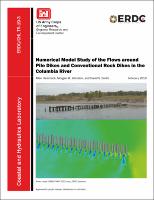Please use this identifier to cite or link to this item:
https://hdl.handle.net/11681/32273Full metadata record
| DC Field | Value | Language |
|---|---|---|
| dc.contributor.author | Hammack, E. Allen | - |
| dc.contributor.author | Johnston, Morgan M. | - |
| dc.contributor.author | Smith, David S. | - |
| dc.date.accessioned | 2019-03-05T16:39:59Z | - |
| dc.date.available | 2019-03-05T16:39:59Z | - |
| dc.date.issued | 2019-02 | - |
| dc.identifier.govdoc | ERDC/CHL TR-19-3 | - |
| dc.identifier.uri | https://hdl.handle.net/11681/32273 | - |
| dc.identifier.uri | http://dx.doi.org/10.21079/11681/32273 | - |
| dc.description | Technical Report | - |
| dc.description.abstract | Will be inserted prior to final review. Pile dikes in the Columbia River are approaching the end of their expected service life. Two replacement options have been suggested: similarly shaped pile dikes and conventional rock dikes. A three-dimensional numerical model study has been conducted to provide flow information to support a decision between the two replacement options. This study focuses on the Cottonwood Island site on the Columbia River. The primary interest is determining the potential navigation impacts of changing from the pile dikes to the conventional rock dikes. The results of this model will also be used to study the secondary interests of effects to fish habitat and the possible operation concerns of scour potential and sediment deposition between the dikes. This report contains a discussion of the geometry and computational mesh development and flow solver used. The flow solutions are presented as contour plots in multiple areas of the flow domain. General trends among the flow solutions between the two types of dikes are evaluated and discussed. | en_US |
| dc.description.sponsorship | United States. Army. Corps of Engineers. Portland District. | en_US |
| dc.description.tableofcontents | Abstract .................................................................................................................................... ii Figures and Tables ................................................................................................................... v Preface ..................................................................................................................................... x Unit Conversion Factors ........................................................................................................ xi 1 Introduction ...................................................................................................................... 1 1.1 Background ........................................................................................................ 1 1.2 Objectives ........................................................................................................... 3 1.3 Approach ............................................................................................................ 4 2 Modeling Process ............................................................................................................ 5 2.1 Governing equations ......................................................................................... 5 2.2 Modeling procedure .......................................................................................... 7 3 Geometry and Computational Modeling ....................................................................... 9 3.1 Flow domain ....................................................................................................... 9 3.1.1 Flow domain extents (planwise) ................................................................................. 9 3.1.2 Flux boundaries ......................................................................................................... 12 3.1.3 Bathymetry and dike geometry ................................................................................ 13 3.1.4 Water surface ............................................................................................................ 18 3.1.5 Northern and southern boundaries ......................................................................... 18 3.1.6 Total flow domain summary ..................................................................................... 21 3.2 Computational meshing ................................................................................. 25 3.2.1 General meshing challenges .................................................................................... 25 3.2.2 Meshing procedure ................................................................................................... 28 3.3 Sand Island meshing attempt ........................................................................ 36 4 Boundary Conditions and Simulation Procedure ....................................................... 37 4.1 Boundary conditions ....................................................................................... 37 4.1.1 Inflow ......................................................................................................................... 38 4.1.2 Outflow ....................................................................................................................... 38 4.1.3 Water surface ............................................................................................................ 38 4.1.4 Other no flux boundaries .......................................................................................... 39 4.2 Simulation procedure summary .................................................................... 39 5 Numerical Model Results .............................................................................................. 40 5.1 High discharge ................................................................................................ 42 5.2 Medium discharge .......................................................................................... 59 5.3 Low discharge .................................................................................................. 76 6 Summary and Conclusion ............................................................................................. 93 6.1 Study summary ............................................................................................... 93 6.2 Design recommendation ................................................................................ 95 References ............................................................................................................................. 96 Appendix A: Sand Island Modeling Attempt ...................................................................... 97 Appendix B: Feasibility of Combining Piles .................................................................... 103 Appendix C: Free Surface vs. Fixed-Lid Water Surface Treatment .............................. 109 Appendix D: Additional Flow Solution Images ............................................................... 117 Report Documentation Page | - |
| dc.format.extent | 171 pages / 23.35 Mb | - |
| dc.language.iso | en_US | en_US |
| dc.publisher | Coastal and Hydraulics Laboratory (U.S.) | en_US |
| dc.publisher | Engineer Research and Development Center (U.S.) | - |
| dc.relation.ispartofseries | Technical Report (Engineer Research and Development Center (U.S.)) ; no. ERDC/CHL TR-19-3 | - |
| dc.rights | Approved for Public Release; Distribution is Unlimited | - |
| dc.source | This Digital Resource was created in Microsoft Word and Adobe Acrobat | - |
| dc.subject | Columbia River | en_US |
| dc.subject | Dikes (Engineering) | en_US |
| dc.subject | Fishes--Habitat | en_US |
| dc.subject | Hydraulic models | en_US |
| dc.subject | Hydraulic structures | en_US |
| dc.title | Numerical model study of the flows around pile dikes and conventional rock dikes in the Columbia River | en_US |
| dc.type | Report | en_US |
| Appears in Collections: | Technical Report | |
Files in This Item:
| File | Description | Size | Format | |
|---|---|---|---|---|
| ERDC-CHL TR-19-3.pdf | 23.92 MB | Adobe PDF |  View/Open |